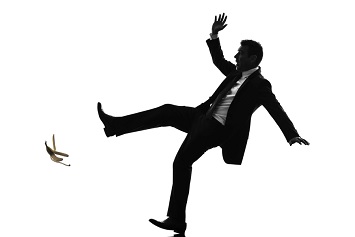According to the Occupational Safety and Health Administration (OSHA), slips, trips, and falls constitute the majority of general industry accidents—and the vast majority are actually falls on the same level, not 30-foot falls from a roof or some other height. Falls cause 15% of all accidental deaths, and are second only to motor vehicles as a cause of fatalities. Have you looked down lately to see what might be tripping up workers at your facility?

Effective interventions for slips, trips, and falls can save a lot in injuries and associated costs. Let’s discuss some big things to watch out for.
Walking Surface Issues
When it comes to slips, trips, and falls, healthcare workers are at higher risk than most workers, so that’s where the National Institute for Occupational Safety and Health (NIOSH) and the Centers for Disease Control and Prevention (CDC) went looking for causes—and solutions.
NIOSH conducted research on slips, trips, and falls in three acute care hospitals, and spent 10 years assessing the effectiveness of preventive measures. Over that 10-year period, workers’ compensation costs arising from slips, trips, and falls in the three hospitals declined by 59%. These preventive measures could help reduce your workers’ comp costs, too.
The specific causes of slips, trips, and falls may vary—the slick floors in your workplace might be created by a different substance than those in a hospital—but the prevention principles can be broadly applied. Major risk factors identified by NIOSH and the CDC include:
Contaminants on floors and walkways. Kitchens, bathrooms, building entrances, and other areas where floors and walkways are often wet or contaminated present this type of risk. Effective preventive measures include:
- Well-documented housekeeping procedures; the CDC suggests creating a written housekeeping program.
- Two-step mopping. This technique, in which a cleaning solution is applied, then removed, is more effective than traditional damp-mopping and may reduce slipping hazards.
- Slip-resistant shoes. In persistently slick areas, workers should wear appropriate footwear.
- Correctly aligning pipes with the drain they empty into, unclogging drains regularly, and redirecting downspouts away from sidewalks.
Indoor walking surface irregularities. Damaged, warped, buckled, or uneven flooring surfaces can cause employees to slip, trip, or fall. Control this risk by:
- Replacing or restretching loose or buckled carpeting;
- Removing, patching underneath, and replacing indented or blistered vinyl tile;
- Eliminating trip hazards over a quarter-inch high in all areas of pedestrian travel, using beveling or ramps;
- Replacing smooth flooring materials in areas normally exposed to water, grease, and/or particulate matter with rougher-surfaced flooring; and
- Making sure elevators are leveled properly so elevator floors line up evenly with hallway floors.
Outdoor walking surface irregularities. Outdoor falls can result from poorly maintained, uneven ground; protruding structures; holes; and rocks, leaves, and other debris. Improve safety by:
- Patching or filling cracks greater than a half-inch wide in walkways;
- Highlighting changes in elevation with Safety Yellow warning paint;
- Eliminating concrete wheel stops in parking lots; and
- Covering or highlighting underground watering system structures.
Weather conditions. Ice, snow, and rain can cause slips and falls. In areas where this is a problem, you can improve safety by:
- Providing additional mats when needed;
- Removing ice and snow from parking lots, garages, and sidewalks promptly;
- Placing freezing weather warning monitors at entrances to employee parking areas;
- Displaying contact numbers for the maintenance department so employees can report slick conditions; and
- Placing bins of ice-melting chemicals in outdoor areas of heavy pedestrian traffic.
Lights, Handrails, and Clutter
Slips and trips are often caused by problems with the floor surface itself—either by irregularities or slippery conditions. However, there are some issues not directly connected to the flooring surface that can also create a hazard, including:
Inadequate lighting. Inadequate lighting makes it harder to see hazards. Make hazards visible by:
- Installing more light fixtures and/or brighter bulbs in poorly lit areas; and
- Installing light fixtures that emit light from all sides.
Stairs and handrails. Poorly designed or maintained stairs and handrails can lead to falls. Make these safer with:
- Slip-resistant treads and nosing that cover the entire tread, especially on outside steps;
- Handrails at an appropriate height (34 to 38 inches from the stepping surface); and
- Handrails that extend the full length of the stairs plus 12 inches at top and one tread depth at bottom.
Tripping hazards. General clutter, loose cords, hoses, and wires pose a tripping hazard along with improperly used floor mats. Eliminate these by:
- Using wall-mounted storage hooks, shelves, and hose spools;
- Marking walkways and keeping them clear;
- Covering cords on the floor with a beveled protective cover;
- Using mats and runners large enough that users can take several footsteps on them, thereby cleaning contaminants off their shoes before the shoes contact the flooring;
- Using beveled-edge, flat, and continuous or interlocking mats; and
- Replacing mats that are curled, ripped, or worn (secure edges with carpet tape if needed).
